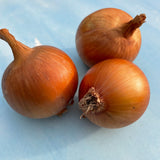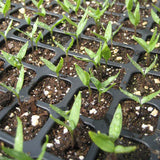
Garden Harvest Spotlight: Cabbage
About Cabbage
Brassica oleracea
Cabbage has been a food staple for hundreds of years. Heavy dense heads store well in the right conditions, and can also be fermented for longer storage as sauerkraut, which was used by Dutch sailors to prevent scurvy due to its high vitamin C content.
Cabbage is actually a biennial, meaning it will go to seed in its second year, but is grown as an annual food crop. Like all cole crops, cabbage is a heavy feeder, and often suffers from inadequate nutrition. Other common issues when growing cabbage are club root, black rot, cabbage moth and flea beetles.
How to plant
Cabbage grows best if started indoors and then transplanted. Start seeds in pots with a rich potting mix 4-6 weeks before planned planting date. In the north-east, some cabbages are good for growing in the summer, while others are a longer season crop that are best if planned on harvesting in the fall.
For spring and summer cabbages, start seeds for Red Acre, Red Express, Early Jersey Wakefield, Perfection Savoy and Purple Savoy from March until May to transplant from April through June.
For fall cabbages, start seeds for Danish Ballhead, Perfection Savoy, and Purple Savoy in late May to transplant in mid-June.
(Cabbage can be grown in the fall and early spring in areas with milder winters, so check your local planting recommendations.)
Transplant cabbage in rich, well-drained soil with a pH between 6-6.6. Cabbages are happiest when they have good soil fertility, and need calcium, phosphorus, potassium and boron in particular, so if you have had difficulty with cabbages (or other cole crops) in the past, try getting a soil test to see if you are deficient in any of these necessary nutrients. Make sure to water steadily throughout the season. Cover with row cover when young if flea beetles are an issue. Check for signs of cabbage worms often, which can destroy your transplants in a matter of days.
How to harvest
Cabbage can be deceptive at harvest time--sometimes what looks like a big, heavy head is a loose, immature one and some heads that look small are ready to be cut--so harvest heads when they are dense and very firm, no matter the size. Once heads are ready to be harvested, cut them without delay. They are quite susceptible to field rot and pests if left out too long.
Savoy cabbages will be dense but not as hard as non-savoyed types. (It is generally a good idea to harvest a head when you think it might be ready, and then slice it open and check to see how dense it is. If there is a lot of space between the leaf layers, then you know to leave the other cabbages that are still in the garden on the plant a bit longer.)
To harvest cabbage, cut the entire head at the base. Remove any outer leaves that are loose. Cabbages are usually a one-time-harvest plant, but if left in the ground, the stalk might produce several small heads under favorable conditions. If you don't leave the plant in the ground, pull it out of the ground and remove any plant debris to keep black rot and other pathogens out of the soil.
Storing cabbage
Before putting the cabbage in the refrigerator for keeping, peel any blemished leaves away and check for cabbage warms or other pests. Healthy, blemish free white cabbages will store in the crisper drawer for months, red cabbages can keep for 1-2 months, and savoy types generally keep for up to 4 weeks.
Uses
Savoy cabbages are great for fresh eating.
Use red cabbage for salads, slaws, sautés and kraut.
Smaller green spring cabbages, such as Early Jersey Wakefield, are sweeter and great for summery side dishes, while the European storage cabbages such as Danish Ballhead make the best sauerkraut and soups.








